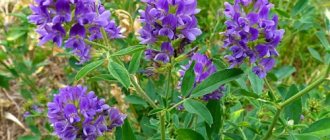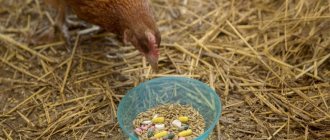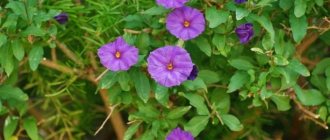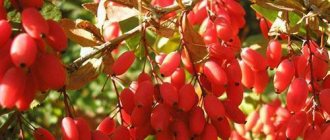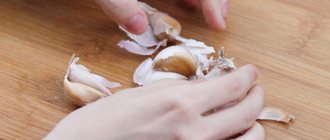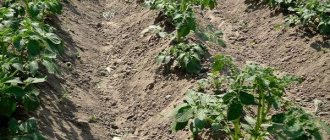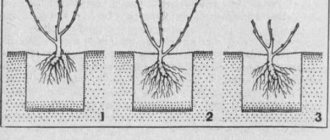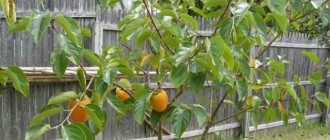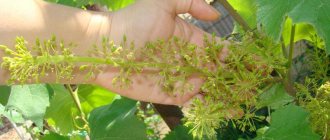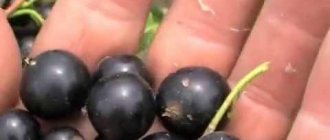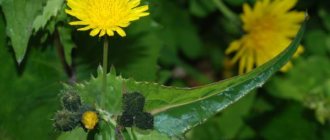Botanical description
Nightshade solanum is a cultivated herbaceous plant bred at the beginning of the 20th century by Luther Burbank, an American breeder, by crossing two nightshades - an African one, which gave appearance and high productivity, and a European one, which provided taste. It was he who christened his brainchild sunberry (sunny berry).
The annual nightshade solanum belongs to the Solanaceae family. Reaches one meter in height, some specimens grow up to 1 m 20 cm, but this is an exception. Usually, in the middle zone, plant growth does not exceed 70 - 100 cm.
The straight stem with frequent branches ends in oblong leaves, reminiscent of an elongated egg, with small teeth along the edge; there are also smooth leaves without teeth. At the time of flowering (June-July) it is covered with small white flowers - with one pistil, five stamens and five fused petals, collected in umbrella inflorescences, which in August turn into alluring blue-black round berries, reaching a diameter of 10 mm. In the fall, the fruits of the beneficial weed nightshade solanum are ready for consumption.
Procurement of raw materials
You can use young nightshade stems, berries and leaves as preparations. When harvesting nightshade stems, the procedure is as follows:
- Cut the stem, measuring 15-20 cm from the bottom.
- The cut stems and leaves of the plant are inspected for rotting, and damaged leaves are torn off.
- Place the nightshade in a place where the sun's rays do not reach. Also, the place should be well ventilated. Periodically turn the plant over until it dries completely.
Raw materials from black nightshade berries have been harvested since August. The procedure for this is as follows:
- Nightshade berries are collected along with the stem organ that holds the fruit.
- The berries are rinsed in cold water and left to dry.
- The berries are then separated from the stem organ that holds the fruit.
- The finished black nightshade berries are poured into a shallow container, having previously laid paper on the bottom. The fruits should not be too close to each other. Dry the berries in the shade, with good air circulation. Fruits must be turned over periodically.
- Fresh prepared fruits are placed on a metal sheet and placed in the freezer for 2 hours. Then the berries are taken out and poured into a bowl.
- The container with berries is filled with sugar in equal proportions. After a couple of hours, the fruits are crushed.
As an option, simply freeze the fruits of black nightshade for the winter. When frozen, nightshade will hardly lose its medicinal properties.
Distribution area
In Russia, nightshade as a plant is widespread in the European part, in the southern regions of Siberia and the Caucasus. It grows everywhere - in vacant lots, around water bodies, along roads - like an ordinary weed, but, thanks to its properties, it is considered useful.
Around the world it grows in Europe, Asian countries, northern America, and even Australia.
Medicinal properties of black nightshade
Benefits and possible harm from using the plant.
It is correct to use fully ripened nightshade fruits. They are extremely rich in sugars, vitamin C, rutin, manganese, calcium, glycosides, organic acids, and carotene.
Unripe berries contain poisonous solanine (alkaloid). The herbaceous part of the plant is rich in ascorbic acid, tannins and carotene. It also includes alkaloids.
The whole plant is considered medicinal - the stem with leaves, fruits and roots. When properly collected, prepared and dosed, the plant acts as:
- Expectorant.
- Painkiller.
- Anti-inflammatory.
- Diuretic.
- Healing.
- Lowering blood pressure.
- Sedative.
It will harm the body only if you pick green or still brown (unripe) berries, and when preparing a decoction or tincture, neglect the indicated dosage.
Benefits of the plant
The beneficial properties of nightshade have been known since ancient times. In those days, both black and yellow-red fruits were used. However, black berries were considered more powerful. In ancient Greece, nightshade was used to treat certain stomach diseases. And already in the Middle Ages, doctors knew that some species of this plant were poisonous.
Chemical composition
This plant has been well studied. In particular, its chemical composition is known. It includes:
- Polysaccharides.
- Saponins (compounds of organic nature that determine the medicinal properties of nightshade)
- Tannins.
- Vitamin C (although most of it is found not in berries, but in leaves)
- Anthocyanins with strong antioxidant properties.
This plant also contains the poisonous alkaloid solanine, which will be discussed below.
Application in scientific medicine
Nightshade extract has now been proven to have the following effects:
- Antioxidant, that is, prevents premature aging.
- Diuretic and, accordingly, hypotonic, since pressure decreases due to the removal of excess fluid.
- Hepatoprotective, that is, it protects liver cells.
- Antitumor (it has been proven that the polysaccharides contained in the plant inhibit the growth of malignant breast tumor cells),
- Anti-inflammatory.
- Anthelmintic, that is, nightshade helps eliminate parasites.
All these properties are used to create medicines based on extracts from the leaves and fruits of the plant.
And the experiments continue. In particular, studies have been conducted that have also proven that preparations based on nightshade have a sedative, that is, a calming effect.
Use in medicine
The herb and fruits of nightshade are still not used in traditional medicine, but they have found serious application in folk medicine.
- It is successfully used to relieve headaches and treat neuroses.
- For hypertension and atherosclerosis.
- Relieves inflammation during exacerbation of rheumatic pain.
- Helps with epilepsy and manifestations of hysteria.
- Relieves asthma attacks and treats colds.
- Soothes the mucous membrane, irritated due to gastritis and other gastrointestinal diseases.
- It has a soothing and disinfecting effect in case of inflammation of the bladder.
- Relieves discomfort during painful heavy menstruation.
- Promotes healing of purulent wounds and boils.
- Reduces symptoms of otitis media and sinusitis.
- Effectively fights parasites.
Several recipes using fruits and leaves
1. A decoction of green parts will help with cystitis, headaches, high blood pressure, and asthma.
To do this, take one small spoon of finely chopped herbs and pour a cup of boiling water. It is better to use enamel cookware. After cooking over low heat for 10-15 minutes, the broth is cooled, then filtered and topped up with boiled water to the original volume.
Also, with high blood pressure, you can eat up to 10 black nightshade berries per day. The pain will go away if you make a headband from crushed leaves.
2. Tincture of leaves for indigestion.
A large spoonful of crushed leaves is poured with boiling water (300 ml) and left for a couple of hours. The strained liquid is taken half an hour before meals. One sip is enough.
3.Rheumatic pain will subside if:
Place the flowers of the plant (1 small spoon) in a cup of boiling water and steep like regular tea. Take several times a day. This will have a diuretic effect and calm the body.
4.Rinse for sore throat and other throat diseases.
Squeeze juice from nightshade berries (about 25-30 ml) and dilute it in boiled water - no more than half a glass. Gargle several times a day.
5. Treatment of wounds.
The preparation of this recipe is different from others. No heat treatment required. It is enough to take 30-40 grams of chopped leaves and fill them with warm water (1.5-2 liters). After a couple of hours, the resulting infusion can be used to treat wounds. This infusion is also suitable for sanitizing the oral cavity.
6. For hemorrhoids.
Dry soaked or fresh leaves can be applied to hemorrhoids - this will greatly relieve pain and reduce inflammation.
Chinese healers use the ash of grass roots with sesame oil - the resulting mixture is used to lubricate inflamed nodes.
What can be made from it?
The use of berries is possible in various ways.
- Fresh. The product is used to treat hypertension, prevent atherosclerosis, get rid of disorders of the genitourinary system, and eliminate inflammation on the skin.
- In the form of an alcohol extract. The plant in this form has a sedative and anticonvulsant effect.
- In the form of juice from ripened fruits. This remedy is effective against inflammation, bacteria, and is used to heal damage.
There are recipes for time-tested remedies based on black nightshade.
- Crowberry ointment. It is used to treat skin diseases, as well as mechanical, infectious, and allergic injuries. For the effect of using the product to be noticeable, the ointment must be applied under the bandage and left for at least two hours. To make the drug, dry nightshade grass should be ground into powder with a mortar or coffee grinder. The finished powder in the amount of one teaspoon should be mixed with vegetable oil in the amount of four teaspoons. The prepared ointment must be used three times a day.
- Berry juice. It is quite an effective remedy for getting rid of swelling, diseases of the skin and mucous membranes. To prepare the juice, you need to grind one glass of fruits using a blender. The resulting puree should be squeezed out using gauze. The resulting juice must be diluted with water in a ratio of one to three. This solution has a beneficial effect when gargling, washing wounds and nasal instillation.
- Herbal decoction. This medicine is used if a person has a cough, cramping, severe pain or inflammation. To prepare a decoction, the crushed herb in the amount of one teaspoon must be poured with a cup of boiling water. The finished mixture is heated in a water bath for fifteen minutes. When the broth has cooled, it must be strained. You need to take the medicine twice a day in the amount of one teaspoon. The shelf life of the product is two days, after which it is necessary to prepare a new portion of the decoction.
- Alcohol extract. This remedy must be taken orally to treat colds, inflammation, problems with bile flow and diseases of the urinary system. The dried fruits of black nightshade must be filled with sixty percent alcohol in a ratio of one to six. The mixture must be infused for at least seven days in a cool place, and it must be shaken daily. The finished extract must be filtered and taken at least fifteen drops 1 or 2 times a day.
- Tincture. This remedy is quite effective if a person is bothered by headaches, joint and stomach pain, as well as nerve disorders. Warm tincture should be used as a lotion on wounds and boils. To prepare the remedy, you need to pour five grams of the herb with a glass of boiling water and leave for at least three hours. Then the tincture is filtered and used externally. When taken orally, you need to drink one tablespoon four times a day.
- Baths. This method of using nightshade herb increases the body's resistance to colds, relieves pain in muscles and joints, and eliminates allergy rashes. It is also effective in the fight against psoriasis and eczema. For this purpose, three tablespoons of the plant must be poured with boiling water in the amount of two liters. The grass is infused until it cools completely. After this, it is necessary to filter and squeeze the cake. The resulting substance must be poured into a bath of water.
There are also known recipes for preparing black nightshade as a culinary dish. You can make jam, preserves, compote, and jelly from the berries. The sweet preparation is often used to fill your favorite pies and desserts. For example, preparing jelly is quite simple:
- the fruits are ground on a sieve;
- pour boiling water;
- bring to a boil, then filter;
- add starch;
- boil until thick.
So, black nightshade is a plant with numerous beneficial properties. Anyone can use this herb in the fight against disorders in the body and various ailments, the main thing is to remember to be careful and follow the recommended dosages.
See below for a review of black nightshade flowering.
- Author: Maria Sukhorukikh
Rate this article:
- 5
- 4
- 3
- 2
- 1
(0 votes, average: 0 out of 5)
Share with your friends!
Contraindications
Due to the fact that nightshade contains toxic substances, its use in any form is prohibited for pregnant women, nursing mothers and children. Because of this, it is not recommended to use it for diseases of the liver and pancreas.
Also, its antihypertensive properties do not allow use with low blood pressure.
Nightshade and the poisonous solanine in it can cause significant harm if used in large quantities, violating the dosage indicated in folk recipes, since even when subjected to heat treatment, it is not completely destroyed.
It must be remembered that unripe berries and young shoots with leaves are very poisonous. Ripe fruits are not dangerous, but they should only be used in doses!
Weed or not?
Not all nightshade species can be considered weeds. These include one species - prickly nightshade. A meter-tall plant that has yellowish thorns on its leaves, stems and peduncles. One bush produces up to 180 berries, each of which contains from 50 to 100 seeds. The peculiarity of the seeds is that they remain viable in the soil for up to 10 years. Can be carried by wind over long distances. If not removed, it can crowd out all herbaceous crops.
Wild species are considered by many to be weeds due to their methods of spread: by birds that eat the berries, or by self-sowing. That is, they can appear where they were not planted or expected.
Danger of poisoning
Having agreed to carry out treatment at home with the help of this plant, you must strictly adhere to the exact dosage. You cannot brew nightshade fruits or leaves by eyeballing them. In this case, poisonous black nightshade will cause harm instead of benefit and create a lot of health problems.
Symptoms of poisoning
You should take it seriously if, after taking the decoction, a person begins to experience:
- Nausea
- Headache
- Cravings in the stomach
- Labored breathing
- Heartbeat
- Increased body temperature
- Diarrhea
In the same case, if vomiting, diarrhea occurs, or consciousness begins to cloud, you should immediately call an ambulance.
Treatment of poisoning
With the listed symptoms, there is no need to waste time while waiting for medical help. Some procedures can significantly alleviate the condition, which will have a positive effect on treatment in the future.
- Try to artificially induce vomiting. To do this, you need to dilute potassium permanganate in water, but do not overdo it with its amount. Just a few crystals will create the desired consistency. They should be thoroughly dissolved in water, or it is better to strain the prepared solution through several layers of gauze, since an unmelted crystal, once on the mucous membrane, will simply burn it.
- If the victim loses consciousness, lay him down and turn his head so that the tongue does not interfere with breathing. Provide unobstructed air access and sprinkle water on the patient’s face, you can sniff ammonia, this will restore consciousness.
The use of the plant, black nightshade, for medicinal purposes has been known for centuries. The main thing is to prepare it correctly. Never pick unripe green berries, due to their high content of poisonous saponin and alkaloids.
Ripe fruits can be used not only as a remedy, but also to make jam, jam or compote from them. Some housewives are happy to prepare for the winter by mixing fresh berries with sugar or honey.
During the cold season, such a product will be one of the few sources of vitamin C, which will strengthen the immune system.
Problems during cultivation
Although nightshade is an unpretentious plant, some difficulties in its maintenance still exist:
- Poor fruiting or lack thereof. This is caused by insufficient pollination during the flowering period. If the plant is not taken out into the open air, it is recommended to pollinate it artificially. For these purposes, use a soft brush, with which pollen should be transferred from one flower to another. To consolidate the effect, the procedure is carried out several times.
- Nightshade sheds leaves and berries. The cause may be drafts, sudden temperature changes or heat. To eliminate these troubles, you just need to find a more suitable place for nightshade.
- Pests. Insects can also cause inconvenience to the plant: whiteflies, aphids and spider mites. Those plants that are kept in dry air conditions are at risk. When you detect the first signs of an insect attack, you should treat the plant with appropriate chemicals or use folk remedies (if the damage is not severe)
